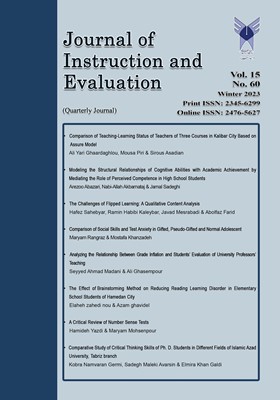-
-
List of Articles
-
Open Access Article
1 - Comparison of Teaching-Learning Status of Teachers of Three Courses in Kalibar City Based on Assure Model
ali yari gharadaghlu Moosa Piri sirous asadiyan -
Open Access Article
2 - Modeling the Structural Relationships of Cognitive Abilities with Academic Achievement by Mediating the Role of Perceived Competence in High School Students
arezoo abazari Nabi-Ollah Akbarnetaj- Shoob Jamal Sadeghi -
Open Access Article
3 - The Challenges of Flipped Learning: A Qualitative Content Analysis
hafez sahebyar Ramin Habibi-Kaleybar Javad Mesrabadi Abolfazl Farid -
Open Access Article
4 - Comparison of Social Skills and Test Anxiety in Gifted, Pseudo-Gifted and Normal Adolescent
MARYAM RANGRAZ Mostafa Khanzade -
Open Access Article
5 - Analyzing the Relationship Between Grade Inflation and Students’ Evaluation of University Professors’ Teaching
Seyed Ahmad Madani Ali Ghasempour -
Open Access Article
6 - The Effect of Brainstorming Method on Reducing Reading Learning Disorder in Elementary School Students of Hamedan City
elaheh zahedi no Azam ghavidel -
Open Access Article
7 - A Critical Review of Number Sense Tests
hamideh yazdi maryam mohsenpour -
Open Access Article
8 - Comparative Study of Critical Thinking Skills of Ph. D. Students in Different Fields of Islamic Azad University, Tabriz branch
Kobra Namvaran Germi Sadegh Maleki Avarsin Elmira Khan Galdi
-
The rights to this website are owned by the Raimag Press Management System.
Copyright © 2021-2025







